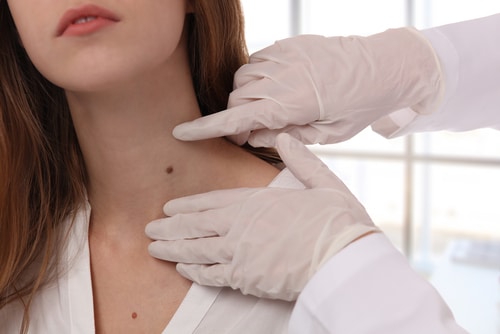Skin Cancer 101: Prevention, Detection, and Treatment

Skin cancer is caused by the development and growth of abnormal skin cells. While often associated with sun exposure, there are some types of skin cancer that develop in areas normally not exposed to sunlight. Usually appearing as waxy/pearly bumps on skin, basal cell carcinoma accounts for about 80 percent of all diagnosed cases, according to the American Cancer Society. Melanoma and squamous cell carcinoma are the other two common types of skin cancer. Take a moment to learn more about skin cancer, including how it’s detected and treated and what can be done to prevent it.
How Is Skin Cancer Detected?
The initial detection of skin cancer is usually visual, although additional testing that often includes a biopsy is needed to make a positive diagnosis. Symptoms associated with skin cancer can vary based on the type of skin cancer but may include unusually shaped or colored moles, red, itchy, or scaly patches of skin that may bleed, or unusual bumps or growths.
In some instances, image tests are done to examine lymph nodes and other nearby structures. A sentinel lymph node biopsy may also be done to examine tissue from the lymph nodes. Results from a biopsy also allow the stage of skin cancer to be determined.
What Are Treatment Options?
With superficial skin cancer, the only treatment necessary may be a biopsy in which the affected tissues are removed and tested. If further treatment is needed, there are several options that may be recommended by Dr. Baird. These include:
• Excisional surgery: Cancerous skin tissue is “cut out,” or excised, with this treatment. After the affected area is numbed, the cancerous tissue along with surrounding tissue is removed to ensure all cancerous cells have been removed.
• Cryotherapy: This treatment involves the removal of excess cancerous tissues after the growth has been removed. It’s completed with an electric needle. Liquid nitrogen may be used as well.
• Mohs surgery: If skin cancer is more extensive or it’s recurring, this treatment may be suggested. The affected tissues are shaved away in layers and examined under a microscope until tissues no longer have cancer cells.
• Photodynamic therapy: Skin cells are destroyed with this treatment by a combination of drugs that make skin cells sensitive to light and a special type of light.
How Can Skin Cancer Be Prevented?
One step you can take prevention-wise is to wear sunscreen, but do this year-round and not just in the summer. The American Academy of Dermatology recommends using products with an SPF of at least 30. You’ll also be increasing your odds of preventing skin cancer by:
• Wearing clothing that covers arms and legs and accessories that might include a visor or broad-brimmed hat when out in the sun for a while
• Being aware of medications that could make your skin more sensitive to sun exposure
• Staying away from tanning beds
• Checking your skin on a regular basis and seeing Dr. Baird if you notice anything unusual
We also do excision closure and reconstruction for patients who’ve had excision treatment to close wounds while maintaining the desired cosmetic skin appearance. If you are seeing signs suggesting you may have skin cancer, Dr. David A. Baird is here to help. Visit Farmington Dermatology for a consultation with Dr. Baird to learn what steps you’ll need to take next. Contact us today to set up an appointment.

